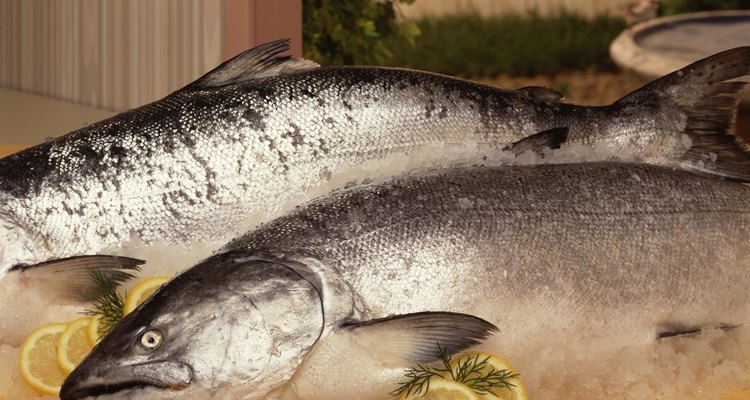
Unless you have the good fortune to live near a salmon river or have an in-law who fishes them commercially, your chances of cooking a salmon when it's really, really fresh are pretty slim. The best choice is often commercially-frozen fish, which are blast-frozen as soon as they're caught. Most recipes assume you're cooking fresh or thawed salmon, but you can also prepare whole salmon direct from the freezer.
The Big Chill
Fish ages rapidly, once it's out of the water. The fresh salmon in your supermarket's display can often be three to four days old by the time you make your purchase, and its flavor suffers correspondingly. In contrast commercially frozen salmon is rapidly cooled in powerful industrial freezer units, freezing the fish solid in a very short time. That's important, because the moisture inside the muscle tissues expands as it freezes. The more quickly it freezes the smaller the ice crystals will be, and the less damage they'll do to the flesh of the fish. The net result is a salmon with almost exactly the flavor and texture it had when it came out of the water.
Poached Salmon, Legally
Poaching salmon isn't a crime in the kitchen, and in fact it's one of the most effective ways to cook a whole fish from frozen. The cooking liquid is usually highly-seasoned water, called "court-bouillon" in French, with a splash of white wine or fresh herbs added. Bring it to a boil in a pan large enough for your salmon, then add the fish and reduce the heat to a simmer. Cover the pan and poach the whole salmon for 8 to 10 minutes, or until it's cooked most of the way through. Remove the pan from the burner and let the salmon rest, covered, for another 6 to 8 minutes. When the flesh turns reaches a pale, cooked pink at the spine in the thickest section, drain and serve the salmon.
Oven-Baked, Fuss-Free
Whole frozen salmon can also be oven-baked, arguably the most trouble-free method of cooking one. Rinse the salmon under cold running water to remove any surface glazing, then pat it dry. Bake the salmon on a parchment-lined sheet pan at 400 degrees Fahrenheit, allowing approximately 12 minutes per inch of thickness. After 12 to 15 minutes you'll probably need to cover the tail portion with foil, to prevent overcooking. When the salmon is almost done but still slightly translucent at the bone, remove it from the oven and cover it loosely with foil. Let it rest for 5 to 8 minutes, to finish cooking, then serve.
The Grill of Your Dreams
Pan-frying a whole salmon isn't really a practical option, but your barbecue grill probably fits all but the largest fish. Rinse away any glazed-on ice under cold running water, then dry the salmon and place it on a large sheet of oiled aluminum foil. Fold and crimp the edges to make a tight package, and put the salmon crimped-side down on a medium-hot grill, approximately 375 F. Cook the salmon for 15 minutes, then open the foil and season it inside and out and add any spices or fresh herbs. Re-seal the foil and return it to your grill for another 10 to 15 minutes, until it's cooked almost to the bone. Rest the salmon, still wrapped for 5 minutes before serving.
Related Articles

Can You Cook Fish Frozen?

How to Freeze Cod Fish

How to Cook Copper River Salmon
How to Bake Salmon So It's Tender

How Long Does It Take for Salmon to ...
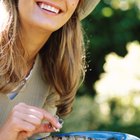
How to Grill a Trout Fillet

Do I Have to Thaw Out Salmon Before I ...

How to Grill a Cod Fish

Baking Partially Frozen Salmon

How Long Do You Bake Salmon in Foil ...

How to Cook Frozen Salmon Fillets ...
How Long Can Halibut Be Kept Frozen?
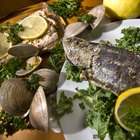
Fish Cooking Temperature
How to Cook Grouper in the Oven

Can You Fry Frozen Tilapia?
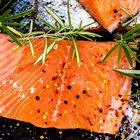
Baked Salmon Filet Nutrition Information

How to Brine a Grilled Salmon
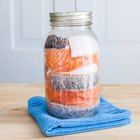
How to Can Salmon Fish

Ways to Cook Salmon Without Butter

Is it Healthier to Cook Salmon With Its ...
References
- On Food and Cooking: The Science and Lore of the Kitchen; Harold McGee
- Cook it Frozen!: Poaching
- Cook it Frozen!: Roasting
Writer Bio
Fred Decker is a trained chef and prolific freelance writer. In previous careers, he sold insurance and mutual funds, and was a longtime retailer. He was educated at Memorial University of Newfoundland and the Northern Alberta Institute of Technology. His articles have appeared on numerous home and garden sites including GoneOutdoors, TheNest and eHow.
Photo Credits
Jupiterimages/Stockbyte/Getty Images